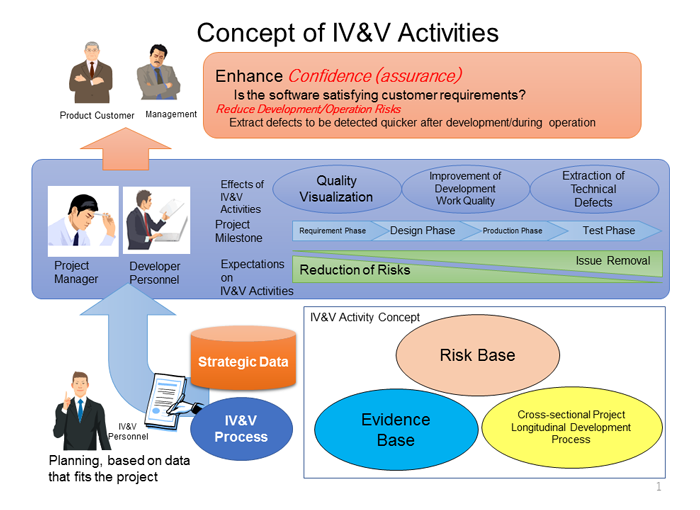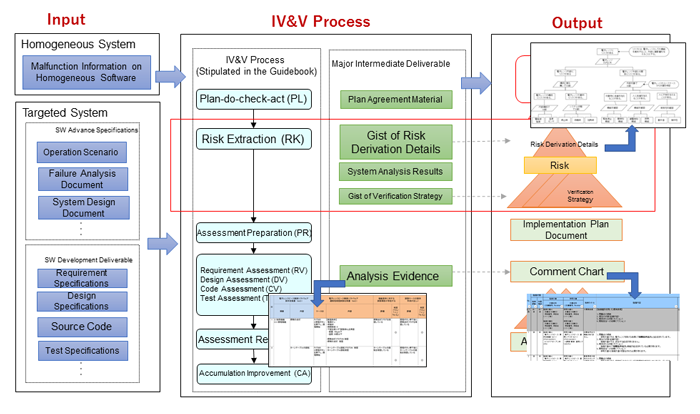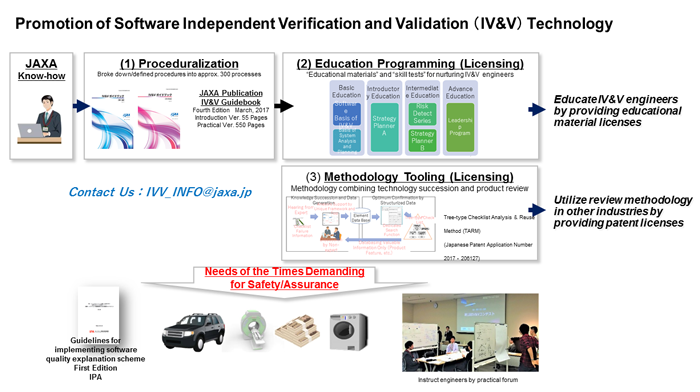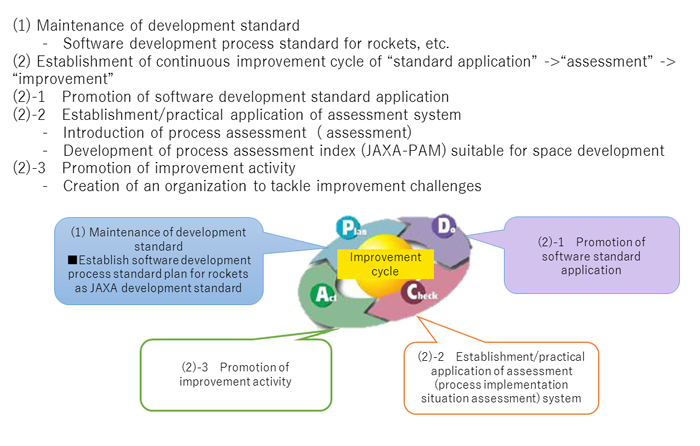Improvement of Reliability on Spacecraft Software (IV&V, Process Improvement)
1. Software Independent Verification and Validation (IV&V)
Space station and spacecraft, including satellites and launchers, cannot be repaired easily once they are in outer space. This situation is same for software to be on-boarded on spacecraft, being difficult to modify or change after launch. However, high reliability is always demanded for spacecraft software, as software defects may lead to a fatal break down for the spacecraft. Our team has implemented °»Software Independent Verification and Validation (Independent Verification and Validation: IV&V)°… as an initiative.
Software IV&V is an activity performed by an organization that is financially and managerially independent from the development department, to identify the issues concerning spacecraft software and reducing potential risks which are hardly noticed in the development department by independent viewpoints and technology.

°ŕContent of Implementation°Ř
Our development department presents deliverables, including specifications and source code to be created during the software development process, and we assess that the software is meeting the requirements for carrying out the mission of spacecraft, and the details of designing and tests are matching the requirements by using methods, such as document reviews, model checking, analysis and simulation from various point of views. We give feedback on the details to the development department in a timely manner, in an event where challenges or issues are discovered in the deliverables during the assessment. Once the entire assessment has been completed, we offer feedback on assessment reports and challenges that should be solved, regarding software reliability targeted for assessment.
°ŕResults°Ř
Software IV&V has been implemented for satellites, including °»Advanced Land Observing Satellite-2 (ALOS2)°… and °»Hayabusa2°…, which already are actively involved, as well as various projects, such as for °»KIBO°…°Ĺa Japanese experiment module for the International Space Station (ISS)°Ĺand for Epsilon launchers, and has contributed to the spacecraft software quality improvement.

2. Development of IV&V Technology
We have utilized cutting-edge methodology of the industrial world to deal with various software development types, and have contributed to software quality improvement. We are also publishing guidebooks for engineers, and providing training and license for methodology, as part of the activity plowing back the established IV&V technology to other industrial worlds, including the automotive world, besides the space industry.
 °›°°Please contact IVV_INFO@jaxa.jp for inquiries on IV&V Guidebook/training/license provision°°°›
°›°°Please contact IVV_INFO@jaxa.jp for inquiries on IV&V Guidebook/training/license provision°°°›
3.Process Improvement of Software Development
Process in the process improvement means °»the way to create°… software, such as requirement analysis, designing, production and testing. Our team aims to build highly reliable software development technology through establishment of a process improvement cycle peculiar to the spacecraft software development.
Process improvement is conducted by repeating the Plan (planning) /Do (execution) /Check (analysis of present state) /Action (implementation of measure) steps. We have started from the analysis of the present situation °»Check°…, regarding the actual improvement activity.
°ŁCheck : Analysis of Present State
We identify issues in the process, examining improvement measures based on the results and implement improvement measures, utilizing latest technologies. This activity is conducted in cooperation with spacecraft software development manufacturers, to build more efficient processes.
°ŁAct : Standardization of Process
Application of the improvement derived by “Check” to JAXA’s standard process, “Software development standard (for spacecraft)”, and application to actual software development has begun. This standard integrates experience and knowledge obtained from the history of development, and is an index for future software development.
°ŁPlan: Promotion of Continuous Improvement
In order to further promote continuous implementation of the improvement activities, we are currently introducing new process assessment technology, and are planning new technology research and practical application, including technology research enabling user-friendly approach by visualizing the process..
°ŁDo: Promotion of Application on Software Development Standard
Process measurement and assessment that lead to “Check” step is required for aiming further process optimization and improvement. Therefore, we are conducting trial activities that lead to improvement, using a method called “process assessment” to check how applied software development standard is being implemented. In addition to a qualitative assessment, we are also conducting a trial test to collect data, which may be a barometer of the process execution situation for seeking a quantitative assessment method.
We are promoting the following three items in the second mid-term plan, (i) establishment of process improvement cycle, (ii) visualization of process/ knowledge sharing and (iii) engineer nurturing.
(ŁŮ) Establishment of Process Improvement Cycle
°¶Maintenance of development standard: Software development process standard for launchers, etc.
°¶Establishment of continuous improvement cycle of °»standard application°… Ę™ °»assessment°… Ę™ °»improvement°…(ŁÚ)Visualization of Process/ Knowledge Sharing
°¶Analyze/define processes related to JAXA development business
°¶Recognition sharing on JAXA project against development standard and development manufacturers, and build a framework that enables °»visualization of process°… and °»accumulation of process knowledge°… to make business implementation to be easy(Łů) Nurturing of Software Engineers That Can Contribute to the Project
 Establishment of Process Improvement Cycle
Establishment of Process Improvement Cycle 

